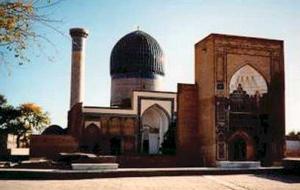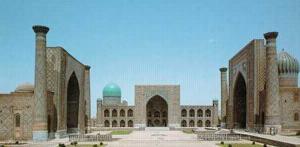
City of Uzbekistan, one of the oldest cities of Central Asia.
The history of Samarkand goes back to well before the 4th century BC, when it was known as Maracanda. It was then the capital of Sogdiana. Alexander the Great took the city in 329 BC. Thereafter it was ruled by
In 1220 Samarkand was conquered and destroyed by the Genghis Khan's Mongol army. In 1365 it rose in revolt against Mongol rule but was raised to the capital of the Mongol empire by Timur. Under his reign Samarkand became the most important cultural and economical centre of Central Asia, and its fame spread across the world. In 1500 it was conquered by the Uzbeks and became part of the Bukhara khanate.
The medieval city of the 11th century was surrounded by an 8 km long wall with six gates, from where roads converged towards the city centre. The walls and gates were destroyed, but the city layout still forms the basis of the old city, which contains several gems of Islamic architecture from Timur's time and the time of his successors.
Samarkand owed its importance to being at the intersection of various trade routes between India, China and the Middle East. The development of sea trade and European colonial expansion reduced the importance of these routes, and Samarkand went into slow decline. Between about 1720 and 1770 the city was uninhabited.
In 1887 Samarkand became the capital of a province in the Russian empire and developed into a railway centre. Today it is the capital of Uzbekistan and an important centre of commerce and tourism.

The Gur-e Amir mausoleum, built on the orders of Timur as a crypt for his dynasty. Timur's body is buried in an underground crypt. An inscription on the tombstone warns not to open his grave.

Registan Square ("Sandy Place"), the heart of the old city. It is surrounded on three sides by the madrasahs of the Mongol rulers Ulugh Beg, Sher-Dor and Tillya-Kari.